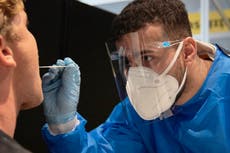Covid: Top 10 coronavirus hotspots revealed as cases rise in nearly half of local areas in UK
Covid at record levels in UK, with one in 13 people estimated to have been infected in a week
Coronavirus infection rates are rising in nearly half of the UK’s local areas, analysis of the latest official statistics suggest – with all but six of the top 100 increases coming in England.
As free universal testing in England was brought to an end this week, health secretary Sajid Javid insisted that people must “learn to live with Covid”.
But with official estimates suggesting cases have hit record levels, a UK Health and Security Agency (UKHSA) spokesperson told The Independent on Saturday that “the pandemic is not over”.
According to the most recent UKHSA figures, which are based on official testing data, the rate of people testing positive for the virus rose in 185 of the UK’s 380 local authorities – nearly 49 per cent – in the week to Sunday 27 March.
Conversely, infection rates fell in 193 local areas – just over 50 per cent – during the same period, and remained unchanged in two places, South Kesteven and West Suffolk.
Of the 10 areas with the highest infection rates, nine were in Scotland. However, eight of the 10 largest week-on-week falls in case rates also came north of the border.
The UK area with the highest infection rate was Na h-Eileanan Siar, in Stornoway, where 2,898 per 100,000 people tested positive for the virus in the week to Sunday 27 March – amounting to a total of 768 cases.
It was followed by the Shetland islands – where 1,635 people per 100,000 tested positive – and south, north and east Ayrshire, which all saw rates of more than 1,560 people per 100,000. After that, the highest rates were in Falkirk, Renfrewshire, Inverclyde, North Devon and West Dunbartonshire.
The 10 areas with the lowest infection rates were all in Wales, with Swansea seeing the lowest rate of 325 positive tests per 100,000 people.
While Scotland enjoyed the largest week-on-week falls in infection rates, all but six of the 100 biggest increases came in England.
The largest weekly increases came in Merthyr Tydfil (51 per cent), South Tyneside (40 per cent), Middlesborough (38 per cent), the Isle of Anglesey, and Hartlepool (both 31 per cent).
However, infection rates in each of these areas remained low in relation to the rest of the UK – with only South Tyneside seeing more than 750 per 100,000 people testing positive in the week to last Sunday.
The top five areas with the highest number of people actually testing positive that week were Cornwall and the Isles of Scilly (7,484), Glasgow City (7,190), the City of Edinburgh (6,608), Wiltshire (6,226), and Leeds (5,746).
However, with these figures including only those who report themselves as testing positive, the Office for National Statistics’ (ONS) weekly infection survey – which extrapolates the results of swabs of tens of thousands of people – is thought to provide a more accurate picture.
The latest ONS figures, published on Friday, make for stark reading. They suggest that 4.9 million people in the UK – equating to one in 13 people – were infected with Covid-19 in the week to last Saturday.
This would be the highest level on record, with the latest surge driven by the more transmissible Omicron variant BA.2
The Zoe Covid study, which is based on self-reported data from members of the public, also suggests that UK cases are at record levels – with nearly 4.5 million people currently estimated to have symptomatic coronavirus.
James Naismith, a University of Oxford biologist, said on Saturday that he believed most people, save for those who are completely shielded or are not susceptible to the virus, would likely be infected with the variant by the summer.
“This is literally living with the virus by being infected with it,” he told the Associated Press.
A UKHSA spokesperson told The Independent on Saturday: “As we learn to live with Covid, we are encouraging people to keep following simple steps to help keep themselves and others safe.
“The pandemic is not over. Covid still poses a real risk to many of us, particularly with case rates and hospitalisations on the rise. That is why it is sensible to wear a mask in enclosed spaces, keep indoor spaces ventilated and stay away from others if you have any symptoms of a respiratory illness, including Covid.
“Vaccination remains the best way to protect us all from severe disease and hospitalisation due to Covid infection. If you have not yet come forward for your primary or booster you should do so straight away – the sooner you are vaccinated the sooner you and your family and friends will be protected.”
Here are the areas with the 10 highest and 10 lowest infection rates, according to UKHSA data, as of 27 March:
Local authority | Number of cases | Infection rate (per 100,000 people)
Highest
- Na h-Eileanan Siar – 768 – 2,898
- Shetland Islands – 374 – 1,635
- South Ayrshire – 1,815 – 1,618
- North Ayrshire – 2,127 – 1,584
- East Ayrshire – 1,899 – 1,561
- Falkirk – 2,505 – 1,560
- Renfrewshire – 2,683 – 1,495
- Inverclyde – 1,128 – 1,463
- North Devon – 1,432 – 1,458
- West Dunbartonshire – 1,275 – 1,443
Lowest
- Swansea – 802 – 325
- Neath Port Talbot – 486 – 336
- Conwy – 412 – 348
- Bridgend – 564 – 382
- Ceredigion – 285 – 391
- Powys – 533 – 400
- Gwynedd – 509 – 406
- Carmarthenshire – 798 – 419
- Flintshire – 671 – 427
- Caerphilly – 778 – 428
Join our commenting forum
Join thought-provoking conversations, follow other Independent readers and see their replies
Comments



Bookmark popover
Removed from bookmarks